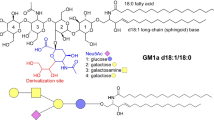Summary
¶ The composition and the content of gangliosides changes during physiological growth and differentiation as well as in neoplastic cell transformation. In order to determine if ganglioside profiles correlate with brain tumour malignancy, the ganglioside distribution was determined in 31 gliomas of astrocytic origin and in non-tumour tissue by a recently developed microbore high performance liquid chromatography (HPLC) method. Glioma malignancy was graded according to the grading system proposed by the World Health Organization (WHO) in 1993. In general, an increase of GD3 and a decrease of normal brain gangliosides correlated with a higher grade of malignancy. Pilocytic astrocytomas Grade I had a distinctive ganglioside profile, histologically as well as biochemically. Although they are low-grade gliomas, the pilocytic astrocytomas exhibited a GD3 content comparable to anaplastic gliomas and could only be biochemically distinguished from other tumour grades by relatively high type “b” ganglioside levels. Thus, ganglioside composition not only reflects anaplasia but can also be used to indicate biological characteristics of tumours of different histogenetic origin.
Similar content being viewed by others
Author information
Authors and Affiliations
Rights and permissions
About this article
Cite this article
Wagener, R., Röhn, G., Schillinger, G. et al. Ganglioside Profiles in Human Gliomas: Quantification by Microbore High Performance Liquid Chromatography and Correlation to Histomorphology and Grading. Acta Neurochir (Wien) 141, 1339–1345 (1999). https://doi.org/10.1007/s007010050439
Issue Date:
DOI: https://doi.org/10.1007/s007010050439




